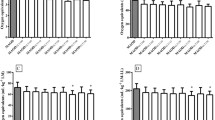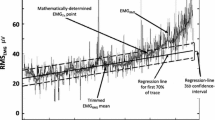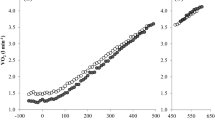Abstract
The purpose of the present study was to investigate the use of electromyographic signals (EMG), to determine the EMG threshold (EMGT) in four lower extremity muscles and to compare these thresholds with the second ventilatory threshold (VT2) in subjects participating in different sports and at different performance levels. Forty-nine subjects (23.8 ± 5.7 years, 182.7 ± 5.3 cm, 79.1 ± 8.6 kg) including eleven cyclists, ten team-handball players, nine kayakers, eight power lifters and eleven controls were investigated utilizing a cycle ergometer. Respiratory gas exchange measures were collected and EMG activity was continuously recorded from four muscles (vastus lateralis, vastus medialis, biceps femoris and gastrocnemius lateralis). The VO2max averaged 56.1 ± 11.1 ml kg−1 min−1, the average aerobic power was 348.5 ± 61.0 W and the corresponding VT2 occurred at 271.4 ± 64.0 W. The EMGT ranged from 80 to 98% of power output for the different muscles. The VT2 and EMG thresholds from four different muscles were not different. When thresholds were analyzed among different groups of subjects, no significant difference was observed between VT2 and EMGT despite threshold differences between the groups. All four EMGT were significantly related to maximal aerobic power (r = 0.73–0.83) and were highly correlated to each other (r = 0.57–0.88). In conclusion, EMGT can be used to determine the VT2 for individuals independent of sport specificity or performance level.




Similar content being viewed by others
References
Abernethy PJ, Jürimäe J (1996) Cross-sectional and longitudinal uses of isoinertial, isometric and isokinetic dynamometry. Med Sci Sports Exerc 28:1180–1187
Bearden S, Moffatt R (2001) Leg electromyography and the VO2–power relationship during bicycle ergometry. Med Sci Sports Exerc 33:1241–1245
Beaver WL, Wasserman K, Whipp BJ (1986) A new method for detecting anaerobic threshold by gas exchange. J Appl Physiol 60:2020–2027
Bland J, Altman K (1986) Statistical methods for assessing agreement between methods of clinical measurement. Lancet 1:307–310
Caputo F, Denadei S (2004) Effects of aerobic endurance training status and specificity on oxygen uptake kinetics during maximal exercise. Eur J Appl Physiol 93:87–95
Chwalbinska-Moneta J, Kaciuba-Uscilko H, Krysztofiak H, Ziemba A, Krzeminski K, Kruk B, Nazar K (1998) Relationship between EMG, blood lactate, and plasma catecholamine thresholds during graded exercise in men. J Physiol Pharmacol 49:33–41
Enoka R, Sutart D (1992) Neurobiology of muscle fatigue. J Appl Physiol 72:1631–1648
Green H, Patla A (1992) Maximal aerobic power: neuromuscular and metabolic considerations. Med Sci Sports Exerc 24:38–46
Hausswirth C, Brisswalter J, Vallier J, Smith D, Lepers R (2000) Evolution of electromyographic signal, running economy, and perceived exertion during different prolonged exercises. Int J Sports Med 21:429–436
Hofmann P, Bunc V, Leitner R, Pokan R, Gaisl G (1994) Heart rate threshold related to lactate turn point and steady state exercise on cycle ergometer. Eur J Appl Physiol 69:132–139
Hug F, Laplaud D, Savin B, Grelot L (2003) Occurrence of electromyographic and ventilatory thresholds in professional road cyclists. Eur J Appl Physiol 90:643–646
Hug F, Decherchi P, Marqueste T, Jammes Y (2004) EMG versus oxygen uptake during cycling exercise in trained and untrained subjects. J Electromyogr Kinesiol 14:187–195
Hug F, Laplaud D, Lucia A, Grelot L (2006) EMG threshold determination in eight lower limb muscles during cycling exercise: a pilot study. Int J Sports Med 27:456–462
Lucia A, Sanchez O, Carvajal A, Chicarro J (1999) Analysis of the aerobic–anaerobic transition in elite cyclists during incremental exercise with the use of electromyography. Br J Sports Med 33:178–185
Mäestu J, Cicchella A, Purge P, Ruosi S, Jürimäe J, Jürimäe T (2006) Electromyographic and neuromuscular fatigue thresholds as concepts of fatigue. J Strength Cond Res 20:824–828
Moritani T, de Vries H (1978) Re-examination of the relationship between the surface integrated electromyogram (iEMG) and force of isometric contraction. Am J Phys Med 57:263–277
Moritani T, Sherman M, Shibata M, Matsumoto T, Shinohara M (1992) Oxygen availability and motor unit activity in man. Eur J Appl Physiol 59:22–32
Moritani T, Takaishi T, Matsumoto T (1993) Determination of maximal power output at neuromuscular fatigue threshold. J Appl Physiol 74:1729–1734
Petrofsky J (1977) Frequency and amplitude analysis of the EMG during exercise on a cycle ergometer. Eur J Appl Physiol 41:1–5
Rowell LB, O´Learly DS (1994) Reflex control of the circulation during exercise: chemoreflexes and mechanoreceptors. J Appl Physiol 68:54–61
Takaishi T, Ono T, Yasuda Y (1992) Relationship between muscle fatigue and oxygen uptake during cycle ergometer exercise with different ramp slope increments. Eur J Appl Physiol 63:335–339
Taylor A, Bronks R (1994) Electromyographic correlates of the transition from aerobic to anaerobic metabolism in treadmill running. Eur J Appl Physiol 69:508–515
Taylor A, Bronks R (1995) Reproducibility and validity of the quadriceps muscle integrated electromyogram threshold during incremental cycle ergometry. Eur J Appl Physiol 70:252–257
Viitasalo J, Luhtanen P, Rahkila P, Rusko H (1985) Electromyographic activity related to aerobic and anaerobic threshold in ergometer bicycling. Acta Physiol Scand 124:287–293
Wasserman K, Beaver W, Davis J, Pu J, Herber D, Whipp B (1990) Gas exchange theory and the lactic acidosis (anaerobic threshold). Circulation 81:14–30
Author information
Authors and Affiliations
Corresponding author
Rights and permissions
About this article
Cite this article
Jürimäe, J., von Duvillard, S.P., Mäestu, J. et al. Aerobic–anaerobic transition intensity measured via EMG signals in athletes with different physical activity patterns. Eur J Appl Physiol 101, 341–346 (2007). https://doi.org/10.1007/s00421-007-0509-5
Accepted:
Published:
Issue Date:
DOI: https://doi.org/10.1007/s00421-007-0509-5




